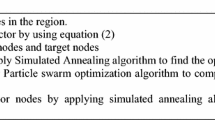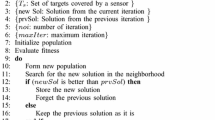Abstract
Sensor deployment is a fundamental issue in Wireless Sensor Networks (WSNs). Studies on the coverage problem are concentrated on deploying sensors to cover determined areas or a set of determined points (targets). On the other hand, the sensor network should have a lifetime long enough to fulfill the application requirements. Therefore, prolonging the network lifetime must be taken into account in designing a solution for a WSN that covers determined points. The problem of determining the location of sensor nodes such that the targets are covered and the network lifetime is maximized is called the sensor deployment problem. So far, various approaches, such as heuristics and approximation algorithms, have been used to solve the sensor deployment problem in WSNs. In this paper, we use two improved versions of the Particle Swarm Optimization (PSO) algorithm to solve the sensor deployment problem. The first one is cooperative PSO and the second one is improved cooperative PSO using fuzzy logic. The simulation results show that the algorithms proposed in this paper solve the target coverage problem with a longer network lifetime compared to the other similar algorithms.












Similar content being viewed by others
References
Ab Aziz NA, Mohemmed AW, Alias MY (2009) A wireless sensor network coverage optimization algorithm based on particle swarm optimization and Voronoi diagram. In: 2009 international conference on networking, sensing and control 2009 Mar 26 pp. 602–607.
Binh HT, Thanh NT, Hanh ND et al (2018) Improved cuckoo search and chaotic flower pollination optimization algorithm for maximizing area coverage in wireless sensor networks. Neural Comput Appl 30(7):2305–2317
Chaudhary M, Pujari AK (2009) Q-coverage problem in wireless sensor networks. In: International Conference on Distributed Computing and Networking pp. 325–330.
Cheng C-F, Wang C-W (2017) The target-barrier coverage problem in wireless sensor networks. IEEE Trans Mob Comput 17(5):1216–1232
Curry RM, Smith JC (2016) A survey of optimization algorithms for wireless sensor network lifetime maximization. Comput Ind Eng 101:145–166
den Bergh F, Engelbrecht AP (2004) A cooperative approach to particle swarm optimization. IEEE Trans Evol Comput 8(3):225–239
Eberhart R, Kennedy J (1995) A new optimizer using particle swarm theory. InMHS'95. In: Proceedings of the Sixth International Symposium on Micro Machine and Human Science pp. 39–43.
Elhoseny M, Tharwat A, Farouk A, Hassanien AE (2017) K-Coverage model based on genetic algorithm to extend WSN lifetime. IEEE Sens Lett 1(4):1–4
Goh CK, Tan KC, Liu DS, Chiam SC (2010) A competitive and cooperative co-evolutionary approach to multi-objective particle swarm optimization algorithm design. Eur J Oper Res 202(1):42–54
Gu Y, Liu H, Zhao B (2007) Target coverage with QoS requirements in wireless sensor networks. In: The 2007 International Conference on Intelligent Pervasive Computing (IPC 2007) 2007 pp. 35–38.
Gupta HP, Tyagi PK, Singh MP (2015) Regular node deployment for $ k $-coverage in $ m $-connected wireless networks. IEEE Sens J 15(12):7126–7134
Huang C-F, Tseng Y-C (2005) The coverage problem in a wireless sensor network. Mob Netw Appl 10(4):519–528
Ismail WW, Manaf SA (2010) Study on coverage in wireless sensor network using grid based strategy and particle swarm optimization. In: 2010 IEEE Asia Pacific Conference on Circuits and Systems pp. 1175–1178.
Kanwar V, Kumar A (2020) DV-Hop based localization methods for additionally deployed nodes in wireless sensor network using genetic algorithm. J Ambient Intell Human Comput. https://doi.org/10.1007/s12652-020-01907-1
Li X, Yao X (2011) Cooperatively coevolving particle swarms for large scale optimization. IEEE Trans Evol Comput 16(2):210–224
Liu H, Abraham A, Zhang W (2007) A fuzzy adaptive turbulent particle swarm optimisation. Int J Innov Comput Appl 1(1):39–47
Liu H, Abraham A, Hassanien AE (2010) Scheduling jobs on computational grids using a fuzzy particle swarm optimization algorithm. Fut Gener Comput Syst 26(8):1336–1343
Lu Z, Li WW, Pan M (2014) Maximum lifetime scheduling for target coverage and data collection in wireless sensor networks. IEEE Trans Veh Technol 64(2):714–727
Mansour M, Jarray F (2015) An iterative solution for the coverage and connectivity problem in wireless sensor network. Proced Comput Sci 63:494–498
Mavrovouniotis M, Li C, Yang S (2017) A survey of swarm intelligence for dynamic optimization: algorithms and applications. Swarm Evol Comput 33:1–17
Mini S, Udgata SK, Sabat SL (2013) Sensor deployment and scheduling for target coverage problem in wireless sensor networks. IEEE Sens J 14(3):636–644
Musa A, Gonzalez V, Barragan D (2019) A new strategy to optimize the sensors placement in wireless sensor networks. J Ambient Intell Human Comput 10(4):1389–1399
Neshat M (2013) FAIPSO: fuzzy adaptive informed particle swarm optimization. Neural Comput Appl 23(1):95–116
Niu B, Zhu Y, He X, Shen H (2008) A multi-swarm optimizer based fuzzy modeling approach for dynamic systems processing. Neurocomputing 71(7–9):1436–1448
Njoya AN et al (2017) Efficient scalable sensor node placement algorithm for fixed target coverage applications of wireless sensor networks. IET Wireless Sensor Syst 7(2):44–54
Özdağ R (2018) Optimization of target Q-coverage problem for QoS requirement in wireless sensor networks. J Comput 13:480
Özdağ R, Karcı A (2016) Probabilistic dynamic distribution of wireless sensor networks with improved distribution method based on electromagnetism-like algorithm. Measurement 1(79):66–76
Ratnaweera A, Halgamuge SK, Watson HC (2004) Self-organizing hierarchical particle swarm optimizer with time-varying acceleration coefficients. IEEE Trans Evol Comput 8(3):240–255
Shi Y, Eberhart RC (2001) Fuzzy adaptive particle swarm optimization. In: Proceedings of the 2001 congress on evolutionary computation (IEEE Cat. No. 01TH8546) pp. 101–106.
Valdez F, Melin P, Castillo O (2011) An improved evolutionary method with fuzzy logic for combining particle swarm optimization and genetic algorithms. Appl Soft Comput 11(2):2625–2632
Wang X, Ma J-J, Wang S, Bi D-W (2007a) Distributed particle swarm optimization and simulated annealing for energy-efficient coverage in wireless sensor networks. Sensors 7(5):628–648
Wang X, Wang S, Ma J-J (2007b) An improved co-evolutionary particle swarm optimization for wireless sensor networks with dynamic deployment. Sensors 7(3):354–370
Wang J et al (2018) A PSO based energy efficient coverage control algorithm for wireless sensor networks. Comput Mater Cont 56(3):433–446
Yarinezhad R (2019) Reducing delay and prolonging the lifetime of wireless sensor network using efficient routing protocol based on mobile sink and virtual infrastructure. Ad Hoc Netw 1(84):42–55
Yarinezhad R, Hashemi SN (2019) An efficient data dissemination model for wireless sensor networks. Wireless Netw 25(6):3419–3439
Yarinezhad R, Hashemi SN (2020) Increasing the lifetime of sensor networks by a data dissemination model based on a new approximation algorithm. Ad Hoc Netw 1(100):102084
Yu J, Wan S, Cheng X, Dongxiao Yu (2017) Coverage contribution area based $ k $-coverage for wireless sensor networks. IEEE Trans Veh Technol 66(9):8510–8523
ZainEldin H, Badawy M, Elhosseini M, Arafat H, Abraham A (2020) An improved dynamic deployment technique based-on genetic algorithm (IDDT-GA) for maximizing coverage in wireless sensor networks. J Ambient Intell Human Comput. https://doi.org/10.1007/s12652-020-01698-5
Zhang J, Ding X (2011) A multi-swarm self-adaptive and cooperative particle swarm optimization. Eng Appl Artif Intell 24(6):958–967
Author information
Authors and Affiliations
Corresponding author
Additional information
Publisher's Note
Springer Nature remains neutral with regard to jurisdictional claims in published maps and institutional affiliations
Rights and permissions
About this article
Cite this article
Yarinezhad, R., Hashemi, S.N. A sensor deployment approach for target coverage problem in wireless sensor networks. J Ambient Intell Human Comput 14, 5941–5956 (2023). https://doi.org/10.1007/s12652-020-02195-5
Received:
Accepted:
Published:
Issue Date:
DOI: https://doi.org/10.1007/s12652-020-02195-5




